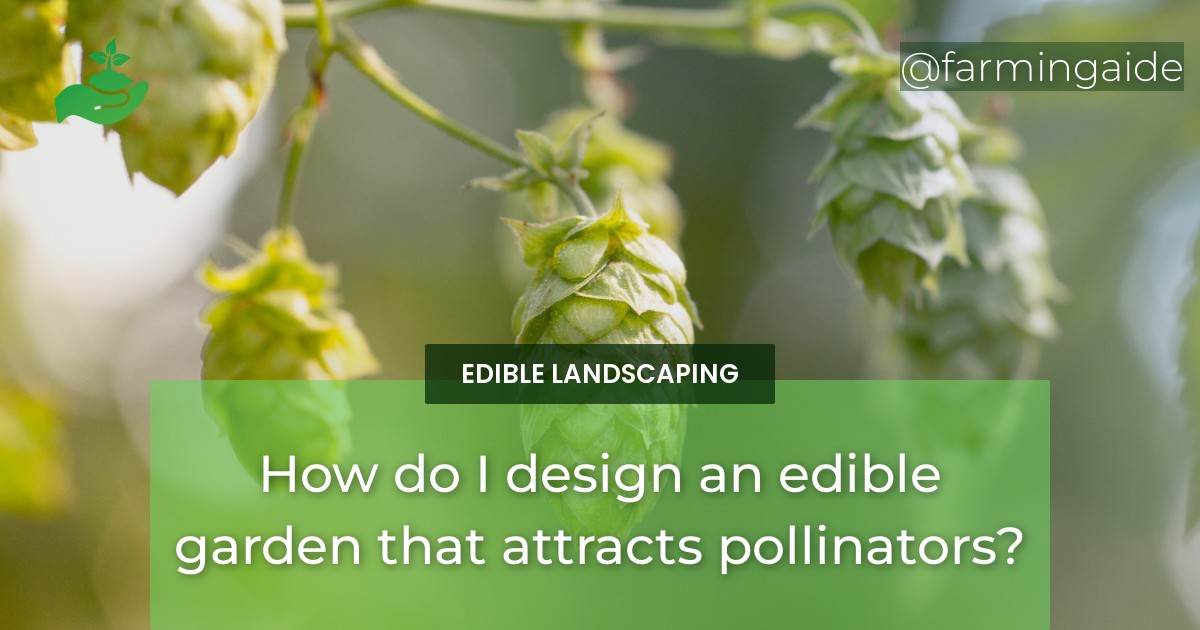An edible garden that attracts pollinators is not only beneficial for the environment but also for your garden’s productivity. Pollinators such as bees and butterflies are vital for pollinating flowering plants, including fruits and vegetables. Without these pollinators, your vegetables and fruits would not produce as well as they could. Here are some tips on how to design an edible garden that attracts pollinators:
Selecting Pollinator-Attracting Plants
Native Plants
Selecting native plants is an excellent way to attract pollinators to your garden. Native plants are adapted to your region’s climate and are more attractive to local pollinators than exotic plants. Native plants also support the local ecosystem and are generally low maintenance. Consider the following native plants:
- Wildflowers
- Dandelions
- Lupines
- Asters
- Coneflowers
Single Flowering Plants
Pollinators are attracted to flowers that are easy to access and provide plenty of nectar. Single flowering plants are an excellent choice because they have a single row of petals that is easy for pollinators to access. Consider plants such as:
- Zinnias
- Marigolds
- Sunflowers
- Black-eyed Susans
Variety of Plants
Planting a variety of plants ensures that pollinators have a diverse source of food. It’s also important to plant flowers that bloom during different times of the year to provide a consistent source of food. Consider the following:
- Herbs such as basil, oregano, and thyme
- Veggies such as tomatoes, cucumbers, and squash
- Berries such as strawberries, blueberries, and raspberries
- Fruit trees such as apples, pears, and plums
Succession Planting
Succession planting involves planting crops at different times, so you always have plants in bloom. This ensures that pollinators always have a source of food. Consider planting quick-growing crops such as lettuce or radishes between longer-growing crops such as tomatoes or peppers.
Providing Water Sources
Birdbaths and Fountains
Pollinators need water, and birdbaths and fountains are an excellent source of water. Be sure to keep the water clean and change it regularly to avoid the spread of disease.
Shallow Dishes and Saucers
Shallow dishes and saucers filled with water are another good source of water. Place them near your plants to make it easy for pollinators to find them.
Dripping Faucets and Hoses
Dripping faucets and hoses can also provide a water source for pollinators. Place a bucket underneath to collect the water, which can then be used to water your plants.
ALSO READ
Creating Habitat for Pollinators
Nesting Boxes and Shelter
Providing a nesting box or shelter is an excellent way to attract pollinators to your garden. Bees and butterflies need a place to lay their eggs and take shelter from the elements. Consider providing a nesting box for bees or creating a butterfly house.
Mulching Techniques
Mulching your garden helps retain moisture, regulate soil temperature, and suppress weeds. Be sure to use organic mulch such as shredded leaves, grass clippings, or straw. This provides a habitat for beneficial insects such as ground beetles and spiders.
Avoiding Pesticides
Avoiding pesticides is essential for creating a pollinator-friendly garden. Pesticides can be harmful to pollinators and can kill them. Consider using organic gardening methods such as companion planting, crop rotation, and using natural pest control methods.
Garden Design for Pollinators
Grouping Plants Together
Grouping plants together makes it easier for pollinators to find them. Consider planting a cluster of flowers instead of individual plants.
Making Use of Vertical Space
Making use of vertical space is an excellent way to maximize your garden’s productivity. Consider planting climbing plants such as pole beans, cucumbers, or tomatoes.
Integrating Edible Plants
Integrating edible plants into your garden design attracts pollinators and provides a source of food for you. Consider planting herbs, veggies, and fruit trees in your garden.
ALSO READ
Maintenance for Pollinator-Friendly Gardens
Deadheading and Pruning
Deadheading and pruning your plants promotes more extensive blooming and keeps your garden looking tidy. Be sure to remove spent flowers and dead or diseased branches.
Removing Invasive Plants
Removing invasive plants is essential for maintaining a healthy garden. Invasive plants can quickly take over and crowd out your pollinator-friendly plants.
Regular Watering and Fertilization
Regular watering and fertilization are essential for maintaining a healthy garden. Be sure to water your plants regularly and fertilize them as needed.
Benefits of Pollinator-Friendly Gardens
Increased Yield of Edible Crops
Pollinators help increase the yield of your edible crops. Without pollinators, your plants will not produce as much fruit or vegetables as they could.
Preservation of Native Pollinators
Creating a pollinator-friendly garden helps preserve native pollinators. Native pollinators are essential for maintaining a healthy ecosystem.
Improved Biodiversity and Ecosystem Health
Creating a pollinator-friendly garden improves biodiversity and ecosystem health. Biodiversity is essential for maintaining a healthy ecosystem.
How can I design my edible garden to also attract pollinators in a vertical setting?
When designing your vertical garden, consider incorporating plants that are known for attracting pollinators in a vertical garden. Choose a variety of flowers and herbs such as lavender, sunflowers, and basil to create an inviting space for bees, butterflies, and other important pollinators.
Conclusion
Designing an edible garden that attracts pollinators requires careful consideration and planning. Selecting pollinator-attracting plants, providing water sources and creating habitat for pollinators, garden design, and maintenance are all essential factors to consider. Creating a pollinator-friendly garden not only benefits the environment but also enhances the productivity of your garden.
RELATED ARTICLES:


